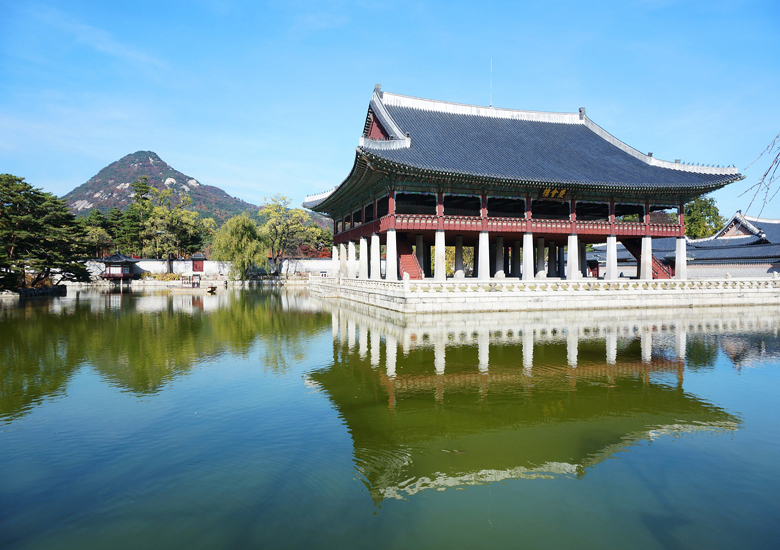Gyeongbokgung is a palace complex in Seoul. . is the first and the largest palace of Five Grand Palaces, which were built in Korea of the Joseon dynasty. it is located in northern Seoul, South Korea , Gyeongbokgung was completed in 1395, three years after the founding of the Joseon Dynasty. Upon completion, the capital of the Gaegyeong dynasty was relocated to Hanyang and served as the king’s residence until its destruction in the Imjin War of 1592. It was only in 1868 that he was rebuilt by King Gojong in the fifth year of rule.
During the Japanese reign (1910-1945) buildings were demolished and the construction changed significantly. 1990 began to reconstruct the palace in its original form . The largest of the five palaces, built during the time of Choson, had 7,700 rooms, housed in 500 buildings on an area of about 40 hectares.
During the Japanese reign (1910-1945) buildings were demolished and the construction changed significantly. 1990 began to reconstruct the palace in its original form . The largest of the five palaces, built during the time of Choson, had 7,700 rooms, housed in 500 buildings on an area of about 40 hectares.
Today, the palace houses the buildings that served the government of the state, the gates and chambers of the royal family , and houses also the National Palace Museum and the National Folklore Museum on its territory. The complex declared Historic Site No.117 (Designated on January 21, 1963).In a poll of nearly 2,000 foreign visitors stated that watching the changing of the guards at the main gate Gwanghwamun is their third favorite activity in Seoul.
Access : Coordinates: 37.578611, 126.977222 / Bus No. 1020, 7025,109, 171, 172, 601 or 606 and get off at Gyeongbokgung Palace Bus Stop./ Subway : Gyeongbokgung Station -Seoul Subway Line 3- and Exit 5.
Anguk Station -Seoul Subway Line 3- and Exit 1. / You can freephone the Korean tourist info number on 1330 and ask about transport options in English.
Attractions- Site Layout :
– Main Gates of Gyeongbokgung : Gwanghwamun (The Main and South Gate),Heungnyemun (The Second Inner Gate),Geunjeongmun (The Third Inner Gate),Sinmumun (The North Gate),Geonchunmun (The East Gate),Yeongchumun (The West Gate)
– Oejeon (Outer Court) : Geunjeongmun (The Third Inner Gate),Geunjeongjeon (The Throne Hall),Sajeongjeon (The Executive Office),Sujeongjeon,Cheonchujeon,Manchunjeon
– Naejeon (Inner Court) : Gangnyeongjeon (The King’s Quarters),Gyotaejeon (The Queen’s Quarters),Jagyeongjeon (The Late Queen’s Quarters
– Donggung (Palace of the Crown Prince): Jaseondang (The Crown Prince’s and Princesses’ Quarters),Bihyeongak (The Study of the Crown Prince) – Pavilions : Gyeonghoeru (The Royal Banquet Hall),Hyangwonjeong /
– Bridges : Yeongjegyo , Chwihyanggyo / – Bihyeongak : Bihyeongak /
– Buildings : Gangnyeongjeon : a building used as the king’s main residing quarters / Geunjeongjeon : known as Geunjeongjeon Hall, is the throne hall where the king formally granted audiences to his officials.
– Gwanghwamun : is the main gate of Gyeongbokgung Palace. / – Gyeonghoeru : known as Gyeonghoeru Pavilion, is a hall used to hold important and special state banquets during the Joseon Dynasty.
– Gyotaejeon : is a building used as the main residing quarters by the queen during the Joseon Dynasty.
– Hyangwonjeong : Hyangwonjeong , or Hyangwonjeong Pavilion, is a , two-story hexagonal pavilion built around 1873 by the order of King Gojong when Geoncheonggung residence was built to the north within Gyeongbokgung.
– Jagyeongjeon : is a building used as the main residing quarters by Queen Sinjeong , the mother of King Heonjong
– Jibokjae : is a two-storey private library used by King Gojong. / – Sajeongjeon : is a building used as the main executive office by the king during the Joseon Dynasty
– Taewonjeon : Taewonjeon is an ancestral shrine originally built in 1868 to house a portrait of King Taejo, the founder of the Joseon dynasty.
– Donggung : Donggung is the lecture hall, where the prince received the preparatory education in order to become a future monarch),
– Geoncheonggung : Geoncheonggung was a private royal residence built by King Gojong within the palace grounds in 1873.
– Governor-General’s Residence : The back garden of Gyeongbokgung used to contain the main part of the Japanese Governor-General’s residence,
– the Gyeongbokgung Palace houses the National Folk Museum of Korea, the National Palace Museum of Korea, and traditional Korean gardens.
Admission Fees : Adults (ages 19-64): 3,000 won / Groups (10 people or more): 2,400 won, Children (ages 7-18): 1,500 won / Groups (10 people or more): 1,200 won
Facilities :Free psrking lots Available , souvenir shops / Restrooms Available
Interpretation Services Offered : Tours depart from in front of the information center at Heungnyemun Gate / From October, Gyeongbokgung starts its night season, from 7PM to 10PM.
Operating Hours : Janunary-February 09:00-17:00 (last admission 16:00),March-May 09:00-18:00 (last admission 17:00),June-August 09:00-18:30 (last admission 17:30),
September-October 09:00-18:00 (last admission 17:00),November-December 09:00-17:00 (last admission 14:00) Closed : Tuesdays
Activities : photo opportunities / Gyeongbokgung Palace Starlight Tour / night view of the Gyeonghoeru Pavilion / Guided group tours / watching the changing of the guards at the main gate Gwanghwamun.
Go next : Presidential Palace Cheongwadae / the Presidential Palace Cheongwadae / Bukchon Hanok village / Seoul / Yeongjong Island

